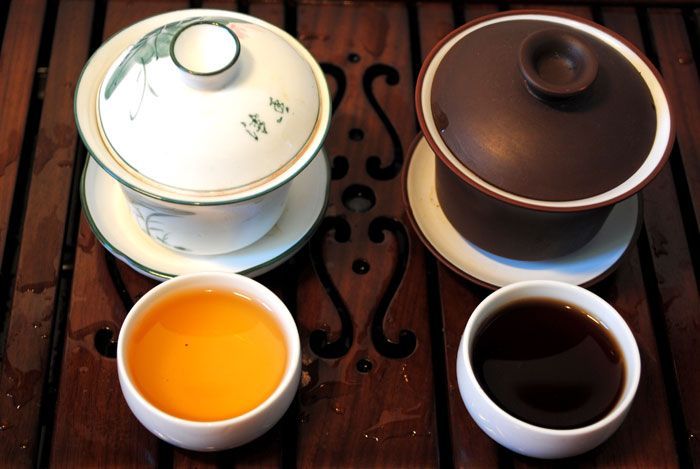What are the differences between Sheng Puer and Shu Puer
What is the difference between Shen Puer and Shu Puer? In this article, I will try to explain the differences between these two types of Puer. There are only two types of Peura - Shen and Shu. There are no others. Both types of Puer are produced in Yunnan province, in southern China. The difference between them is in color, taste and aroma.
Now in order:
- Color
Shen PU'er is a light PU'er. In turn, Shu PU-erh dark PU-erh. Visually determine which Puer you are holding in your hands is not difficult - just look at its color. From Shen PU-erh leaves are pale green or brownish-green color, and Shu Puerh is a dark brown color. It should be noted that in some cases, the color of the leaves of Shen Puer is quite dark and the color is close to Shu Puer.
Photo of Shu and Shen.

- Infusion
Shen Puer gives a light, translucent infusion.
Shu Puer-dark, thick, opaque infusion.

- Fragrance
If we talk about the flavors of these Puer, they are radically different - both in dry and brewed form. Shen Puer has a pronounced "fruity", sweet, rich aroma. At that time, like Shu Puerh aroma is heavy, earthy.
- Taste
Sheng PU'er has a peculiar taste, which has a sourness and a little sweet aftertaste. If Sheng Puer is overexposed during brewing, it will start to taste noticeably bitter. The taste of Shu Puer is heavier, but softer. It is neither sour nor bitter, and there is no sweetness in it at all. But it is characterized by a certain "chocolate".
Shu and Shen Puer are very different teas.
So why is there such a difference between them, because the same tea leaf is used in production? It's all about production technology. It is different. The history of Sheng Puer has more than 700 years. While the Shu Puer started producing only about forty years ago. Sometime in the late seventies. In the production of Sheng Puer, the collected leaf is dried in the open air, then processed by performing a number of manipulations with it (which I will definitely tell you about, but later), and then pressed into the form of a pancake. With Shu Puer, it's a little more complicated. The collected tea leaves are dried, then dumped in giant heaps and filled with water. In such heaps, the tea leaf independently warms up to fairly decent temperatures and begins to burn. This process of debating or "artificial aging" makes the tea leaves dark and changes their aroma and taste. Next, the tea leaf Shu Puer is also pressed into pancakes, but they look different.
If you have never tried either Puer, but really want to and do not know what to start with, then I will tell you how to do it. Ask yourself the question, which teas do you prefer? Red? Or green? If you are a fan of red teas with their masculine and tart flavors, then you will most likely like Shu PU'er. If you prefer the lightness and freshness of green teas, then try to start with Sheng Puer.
Although, of course, if we are to be honest, we need to know both. After all, these are completely different flavors. Completely different taste sensations. Completely different emotions
- Comments
